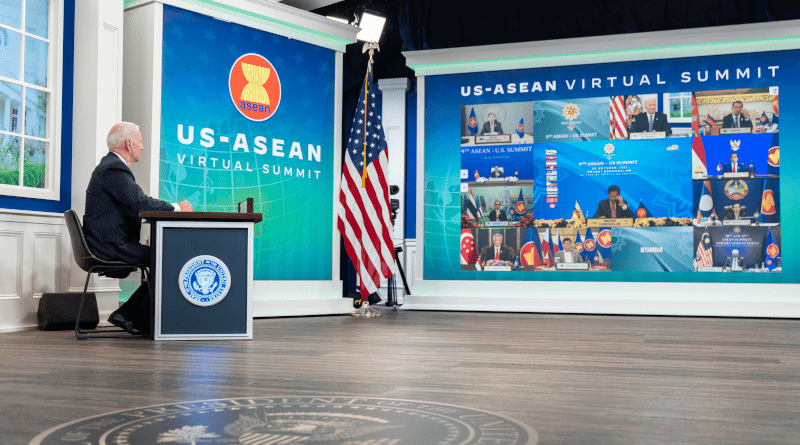Biden Must Build Stronger Trade Ties With ASEAN – Analysis
By Kevin Rutigliano*
On 26 October 2021, US President Joe Biden attended a virtual US–ASEAN summit meeting — the first time in four years that the United States engaged at the highest level with the 10-member bloc. During his speech, Biden said that Washington is committed to the central role ASEAN has in the Indo-Pacific region.
He also announced plans to provide US$102 million in spending to expand the US–ASEAN strategic partnership, which will go toward economic, climate, health and education programs.
The United States had not met with ASEAN at the presidential level since former president Donald Trump attended a meeting in Manila in 2017. Biden’s attendance and remarks at the summit signal that Southeast Asia is a higher priority for the current administration. But Biden will need to deepen trade ties with the region to convince ASEAN countries that the US commitment to Southeast Asia will be long-lasting.
Washington has continued to build up security relations with traditional regional partners, such as Thailand, Singapore and the Philippines, and consolidate security ties with Vietnam. It has also continued to carry out freedom of navigation operations in the South China Sea to pushback against Chinese behaviour there.
But the formation of AUKUS — a trilateral security alliance with the United Kingdom and Australia — and increasing engagement with the Quad signify a US shift towards ad-hoc multilateralism.
ASEAN’s reaction has been ambiguous, with some members concerned that these initiatives could undermine ASEAN’s central place in the regional architecture. Despite these concerns, the United States remains the top security partner for most ASEAN countries.
Washington has lagged behind Beijing when it comes to trade ties with ASEAN. Over the past decade, China has significantly increased bilateral trade with ASEAN countries through the implementation of the ASEAN–China Free Trade Agreement, which went into effect in 2010. In 2009, trade between ASEAN and China stood at US$178.18 billion, compared to an estimated US$685.28 billion in 2020. Total trade between ASEAN and the United States grew from US$148.78 billion to an estimated US$362.2 billion during the same period.
Both China and ASEAN are part of the Regional Comprehensive Economic Partnership (RCEP), the world’s largest free trade agreement, which covers 30 per cent of the global economy. RCEP is likely to further entrench China’s economic influence in ASEAN after it goes into effect in 2022. By comparison, the United States only has one free trade agreement with an ASEAN country, Singapore.
To increase economic ties with ASEAN countries and push back against Chinese economic influence in the region, the United States should rejoin the Comprehensive and Progressive Agreement for Trans-Pacific Partnership (CPTPP). Under the Obama administration, the United States tried to increase its trade with the region through the Trans-Pacific Partnership, a 12-member free trade agreement including four ASEAN countries — Brunei, Malaysia, Singapore and Vietnam. But president Trump withdrew from the deal in 2017.
The remaining members of the pact kept a version of the deal alive through the CPTPP, which went into effect in 2018. Rejoining the CPTPP would increase US economic influence in Southeast Asia. The United States would increase its trade ties to the four ASEAN countries in the agreement and economic ties to ASEAN countries that have not yet joined the pact.
Thailand, the Philippines, Indonesia, South Korea and the United Kingdom have all expressed interest in joining the CPTPP. The addition of the United States would likely make the trade agreement more attractive to these countries. Such an expanded CPTPP would represent over 45 per cent of world GDP, which would enable CPTPP to shape global rules and standards moving forward.
The Biden administration has given no indication that the United States will join CPTPP, partly due to the protectionist political climate at home. Instead, Biden announced at the East Asia Summit that Washington will begin discussions on a regional economic framework with its partners in the Indo-Pacific. While statements indicate that the framework would likely include initiatives for cooperation on tech, infrastructure standards and supply chains, cooperation in these areas is already happening in the region.
In September 2021, China applied to join the CPTPP. All 11 members of the CPTPP would have to approve China’s entry. Given China’s currently strained relations with Japan, Canada and Australia, this is unlikely to happen soon.
But China’s application to the CPTPP is a shrewd diplomatic move. It promotes the image that China supports economic integration in the Indo-Pacific and highlights the continued absence of the United States from the pact. This is especially significant given ASEAN countries tend to view economic ties as more important than traditional security cooperation.
The United States may have to join the CPTPP sooner rather than later to offer an economic alternative to China and demonstrate to ASEAN the long-term US commitment to the region. Otherwise, the United States may find itself less economically relevant in the Indo-Pacific as China’s influence grows.
*About the author: Kevin Rutigliano is a Lecturer in the International Studies (ASEAN-China) Program at Thammasat University.
Source: This article was published by East Asia Forum

